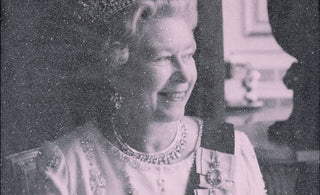
Queen Elizabeth II is the most painted person in the country - and easily one of the most painted women in history. She was painted by artists from around the globe in many different artistic styles throughout her 70-year reign.
But what are the top paintings of Her Majesty the Queen? Read on for more information about some of the best Queen Elizabeth II paintings, from artists such as Andy Warhol, Lucian Freud and Christian Furr.
Rob Munday - Holographic Portrait of Her Majesty The Queen
Rob Munday is one of the top names in the portrait scene, known for creating the iconic official 3D/ holographic portrait of Her Majesty Queen Elizabeth II. He first learned the art of holography in his final year of university at Plymouth University.
Doing so, he became one of the first on the holography scene in the UK. His career was cemented when he was commissioned to create the first-ever official holographic portrait of the Queen in 2003.
Upon completion, he became the first royal holographer. The Jersey Heritage Trust commissioned the painting in order to mark the island’s 800-year allegiance to the throne. Munday’s painting of the queen features his classic attention to detail that helps bring the portrait to life. The painting is a striking representation of the Queen, depicting her in an accurate manner.
His use of colour and light creates a sense of depth and realism, from the lines on her forehead to her detailed eyes. The commission was a collaboration between Munday and Chris Levine. Munday later created the first-ever holographic postage stamp featuring a holographic Head of State in 2011 to commemorate the Queen’s Diamond Jubilee.
During the Queen’s Diamond Jubilee visit to Richmond Park, the Queen was presented with Munday’s portrait of herself. The iconic portrait can also be found on the world’s first £100 banknote and was also featured on the cover of Time Magazine back in 2012.
Munday’s work can be found in collections and galleries all over the world - for example, the National Portrait Gallery, The Royal Collections Trust, the Imperial War Museum and many more.
Lucian Freud - Queen Elizabeth II
British portrait painter Lucian Freud was one of the most prominent 20th-century portraitists in England, known for iconic works such as Girl with a White Dog, Reflection (Self-Portrait), and Man with a Feather.
This portrait was considerably smaller than his other works, measuring just 9.5 x 6 inches. Despite being small in size, it does not lack in quality. Freud requested that the Queen wore the 1820 Diamond Diadem for the painting - and she did so. Shockingly, this portrait was not a commission. Instead, Freud simply requested that he paint the Queen and she agreed.
He then donated the painting to the Royal Collection Trust. Usually, Freud would paint his subjects at his Holland Park studio. However, for the portrait of the Queen, he travelled to St James’s Palace. The painting took around six months to complete and was finalised by December 2001.
The painting was the subject of controversy due to Freud’s artistic style; he didn’t hide any signs that the Queen was ageing. He painted in his typical style that could be perceived as unflattering. Many drew similarities between his self-portraits and his portrait of the Queen, which lead some people to believe that his portrait of the Queen was a stand-in for himself.
Lucian Freud’s work is one of the most famous portraits of the Queen.
Andy Warhol - Queen Elizabeth Pop Art
Warhol is one of the most notable names in the art world, known for his iconic Cambell Soup series and his Marilyn Monroe prints. He was a leading figure in the Pop Art movement and had a fascination with celebrities and iconic figures, which is clear in his artwork.
He has an interesting history, with many interesting facts about his work. This fascination led him to create a distinctive series of stylised portraits of Queen Elizabeth II. Using his classic silk-screening technique, Warhol transformed Her Majesty's image into bold, colourful compositions that emphasised her status as a cultural and political icon.
This piece is from Warhol’s 1985 portfolio - Reigning Queens. This consisted of 16 prints made of up 4x images of four female monarchs ruling the world at the time:
- Queen Elizabeth II
- Queen Margrethe II of Denmark
- Queen Beatrix of the Netherlands
- Queen Ntombi Trala of Swaziland
He uses the same basic image of the queen in four prints, varying in colour. Warhol began this style in the mid-70s, experimenting with overlays and colour. The print not only celebrates the monarchy but also questions the notion of fame and its commercialisation.
Warhol's Queen print continues to captivate audiences worldwide, highlighting the artist's ability to merge art, politics, and popular culture in a thought-provoking and visually pleasing manner.
Christian Furr - Portrait of Queen Elizabeth II
It’s not just already-established painters with decades of experience who have painted Queen Elizabeth II. Christian Furr became the youngest artist to paint the Queen at age 28 back in 1995. In fact, HM Queen Elizabeth II personally picked Furr to be commissioned by the Royal Overseas League.
This was a significant milestone in his career and established his reputation as a highly skilled portrait artist. The portrait, painted in the yellow drawing room at Buckingham Palace, now hangs on display at the Royal Overseas League headquarters in London and can be viewed by members of the public.
Furr is highly sought after for his portraits, and his work is collected privately around the world, including prominent art collectors and members of the royal family. Christian Furr's work is also exhibited in museums and prestigious galleries around the world, from the Museum of Modern Art in Moscow to the National Portrait Gallery in London.






